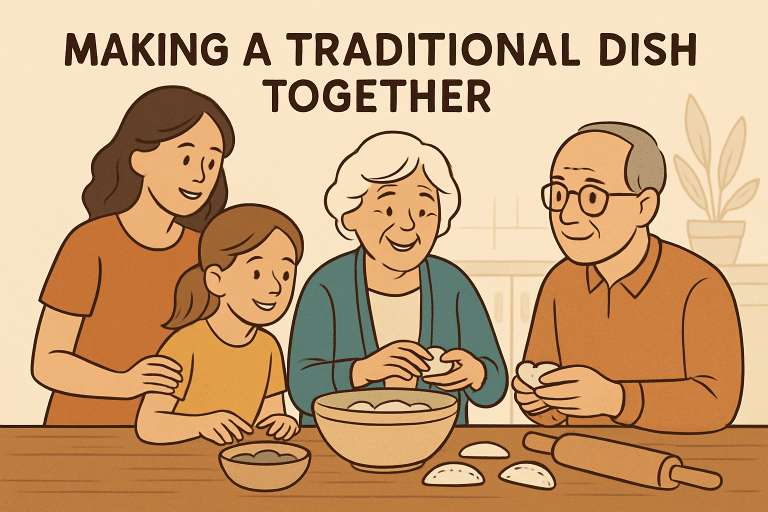Table of Contents
- Introduction
- The Role of Family Recipes in Preserving Memories
- Culinary Traditions as Cultural Bridges
- Teaching and Learning Through Cooking
- Preserving Family Legacy Through Recipes
- Culinary Storytelling and Community Tables
- The Future of Food Heritage
Introduction
Food is not just a means of nourishment—it’s a profound connector that weaves together the narratives of families and entire cultures. Every bite from a family recipe can stir powerful emotions and memories, anchoring people to their roots. Cooking becomes a vessel for intergenerational understanding and respect through shared meals and rituals. These sacred traditions are also deeply intertwined with stories of resilience, love, and sometimes vulnerability, as highlighted by individuals like Claudette Spinelli, who remind us to cherish and protect our elders and their knowledge.
In a rapidly globalizing world, preparing and sharing ancestral dishes is more than upholding a habit; it is a celebration of identity. Culinary traditions uphold family legacies and fortify bonds, ensuring that stories and values are passed down through taste and time. For many, kitchen tables double as storytelling corners, where tales of migration, survival, and joy are seasoned into every meal.
Alongside emotional nourishment, culinary practices strengthen the bond of community. By preparing a treasured dish, people honor those who came before while inspiring those who will follow. The process of passing on these recipes and stories ensures that the essence of family and culture is preserved, cherished, and evolved with each generation.
As food becomes a universal language, it fosters connection within families and across cultures. It encourages mutual understanding and inclusivity, opening doors for shared learning and collaborative celebrations. Exploring the role of culinary heritage, we see how traditions—when shared mindfully—transcend borders and inspire unity. For a deeper understanding of how migration influences food and identity, you may find the perspectives from National Geographic particularly enriching.
The Role of Family Recipes in Preserving Memories
Family recipes are uniquely powerful mementos. They tell the story of generations through flavor, aroma, and texture, giving life to ancestors’ memories. Cooking a recipe from scratch—using the same techniques taught by previous generations—can transport individuals back in time, evoking the laughter, warmth, and togetherness of family gatherings. These recipes become an emotional archive, capturing the essence of loved ones and the eras in which they lived.
Culinary Traditions as Cultural Bridges
Cuisine often reflects migration, adaptation, and the blending of different identities. Dishes brought from homelands and adapted to new locales act as touchstones, reinforcing cultural identity while embracing change. Cooking and sharing these traditional dishes enable families to teach younger members about their ancestry, values, and the unique stories that define them. Simultaneously, these same dishes provide opportunities to introduce outsiders to a culture, gently breaking down barriers and fostering empathy, as evidenced in resources from National Geographic.
Teaching and Learning Through Cooking
Transmitting cooking techniques and recipes from one generation to the next is a dynamic educational process that speaks to the senses and heart. Elders guide young hands through intricate preparations, passing down recipes and the unwritten rules of family life—how to share, be patient, and savor the fruits of one’s labor. Through this hands-on learning, generations connect beyond words, forging memories that resonate for a lifetime.
Preserving Family Legacy Through Recipes
Collecting and documenting family recipes is a powerful act of preservation. Creating family cookbooks, digitizing handwritten notes, and recording videos of elders as they cook ensure that these traditions are not lost to time. This inclusive process strengthens intergenerational bonds, inviting everyone into the family’s story. In safeguarding culinary customs, families reinforce their identity and endow future generations with the gift of heritage.
Culinary Storytelling and Community Tables
Gathering around a table is a natural stage for storytelling. Meals prepared and shared become an opportunity to recount pivotal events and personal tales, cementing connections within families and communities. These communal gatherings foster understanding across generations, ensuring that even the youngest members are steeped in their people’s values and shared history.
The Future of Food Heritage
The ongoing transformation of society poses challenges and opportunities for preserving food culture. While recipes adapt to new ingredients and lifestyles, the core values remain unchanged. Community initiatives, such as cooking classes and social media recipe exchanges, are vital for engaging younger generations and celebrating diversity within traditions. By honoring the past while embracing change, food heritage’s future is secure and ever-evolving.
Food traditions offer a resilient thread that weaves families and cultures together. Through mindful participation in these practices, families empower younger generations to honor the past and shape a shared, meaningful future—one meal at a time.
